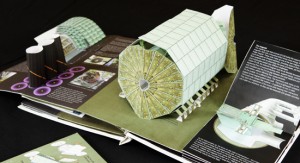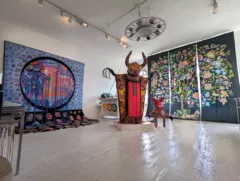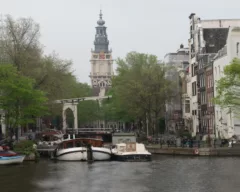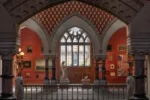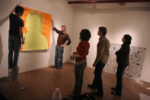Here are a few books which might solve some of your holiday gift problems:
Anton Radevsky and Emma Saunders Voyage to the Heart of Matter; the Atlas Experiment at CERN (Papadakis Publisher: Winterbourne, UK, 2009; 2nd ed. 2010; distributed by Antique Collectors Club, New York) ISBN-10: 190650606X, 13: 978-1906506063
Whether you think art and science are on parallel journeys, find beauty in industrial architecture or just love pop-up books, this is a treat. It’s hard to imagine who conceived the idea of doing a 3-d book on the Large Hadron Collider, the experimental equipment near Geneva constructed to explore the most basic building blocks of the universe; it was written by Emma Saunders of CERN (the European Center for Nuclear Research, which has a wonderful website) with paper engineer and illustrator Anton Radevsky. In order to complete the model of the accelerator, additional pieces enclosed in an envelope inserted into the center of the pop-up must be assembled; but who said physics was supposed to be simple? The pop-up of the Big Bang requires no further effort. It’s a bargain at less than $25 (if the price is much higher, it’s for the first edition).
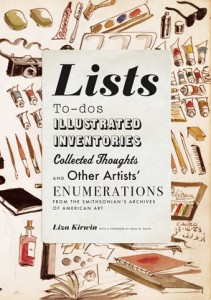
Lisa Kirwin Lists, To-dos, Illustrated Inventories, Collected Thoughts and Other Artists’ Enumerations from the Smithsonian’s Archives of American Art (Princeton Architectural Press: New York, 2010) ISBN 978-1-56898-888-7
This is a good stocking-stuffer for your more obsessive friends and for those who like books that can be read in one-page modules. The Archives of American Art has thousands of lists, explains Lisa Kirwin, curator of manuscripts, who conceived the book: to-do lists, membership lists, lists of paintings sold, appointment lists and so on. Sixty-nine are reproduced in manuscript with a few sentences of context; an appendix gives selected transcriptions and translations. They run from the mundane to the didactic: Adolf Konrad’s entirely visual catalog of things to be packed for a trip, including two pair of undershorts and 23 tubes of paint (as well as 2 trays of watercolors, bottles of ink, and various drawing implements); Robert Morris on alternative terms for earth works: dirt art, … geometric quagmires,… minimal muck,… Nature at her fatuous flat chested best; Gordon Newton’s $100 invoice for Sam Wagstaff, who was supporting him, which includes Bad Habits $5; Hans Hoffman’s “About the Relations of Students and Teachers”: 1) What a teacher should know from the beginning: there is always an apostle who will deny his master.
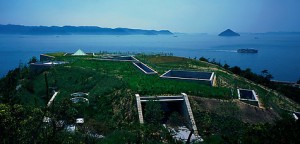
Museums in the 21st Century; Concepts, Projects, Buildings Suzanne Greub and Thierry Grub, editors (Prestel: Munich, 2008, 2nd edition) ISBN 978-3-7913-3840-8
Museums are prestige projects, and their planning and construction continues around the globe. Richard Rogers’ and Renzo Piano’s Centre Pompidou, built in Paris in 1977, presented a totally new conception of museum architecture and Frank Gehry’s Guggenheim Museum, Bilbao (1991-97) made the building itself the star as well as the driver of civic prosperity. The editors think 21st century museums needn’t choose between designing buildings either to house collections or to make independent statements. While a number of books address recent museum architecture, none is so deeply informative and international as this volume, the catalog for an international exhibition that opened in 2006 and is booked through 2011, with further venues possible. One article introduces the general theme and four further articles discuss recent museum projects in Japan, Australia, Europe and the U.S. The strength of the book is its illustrations: 27 museum projects (a few, such as Gehry’s for the Corcoran, may never be realized) include plans, various analytical drawings, sketches and site plans. Each has a short essay by various academics, curators and writers. The book itself is a beautifully designed object (except for the dust jacket), with a textured, silver binding that makes a suitably architectural reference.
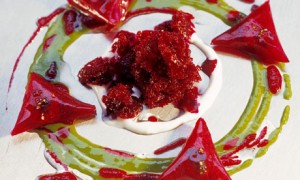
Food for Thought, Thought for Food Edited by Richard Hamilton and Vicente Todoli (Actar, Barcelona and New York, 2009) ISBN 978-84-96954-68-7
The British artist Richard Hamilton and Vicente Todoli, then Director of Tate Modern, have edited this most odd but intriguing book about one of the participants in Documenta 12 (in 2007): Ferran Adrià. If the name doesn’t ring a bell, Adrià is the proprietor and chef of elBulli, a restaurant in a small, Catalan town on the Costa Brava which has widely been hailed as one of the world’s greatest for a number of years. The book will likely be cataloged in the food section, which is a shame, since it more properly addresses definitions of art (why a chef was chosen to participate in a major international art exhibition) and curatorial issues: in what form could a chef participate? It includes a visual catalog of all of Adrià’s creations (albeit postage stamp sized), a number of more proper illustrations of dishes, a menu for Documenta and photographs of Documenta’s diners. There’s also an amusing survey of 20th century (and occasional earlier) artworks involving food, from the expected (Daniel Spoerri, Dieter Roth, Antoni Miralda, Rikrit Taravanija) to the surprising (Paul McCarthy, Martha Rosler, Bruce Nauman, Peiro Manzoni). From the silver binding with Matt Groening’s portrait of Adrià on the cover to the assorted fold-outs and inserts, the book is imaginatively designed, and will more likely be appreciated by readers of art books than cookbooks.
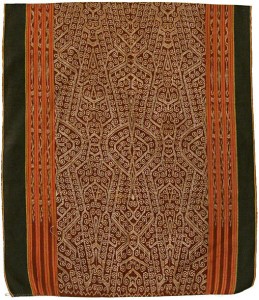
Five Centuries of Indonesian Textiles Ruth Barnes and Mary Hunt Kahlenberg, eds. (Delmonico Books, Prestel: Munich and New York, 2010) ISBN 978-3-7913-5071-4
Indonesia has one of the world’s greatest textile traditions, based on extraordinary weaving and dying, but it interests textile scholars and anthropologists for another reason: the thousands of islands each have individual traditions, which can be studied in isolation and in interaction with each other. Furthermore, Indonesia’s location at the nexus of sea trade means that its textiles also interacted with those of China, India, and later with Europe. This absolutely beautiful volume will interest anyone who cares about textiles and patterned decoration, and the illustrations alone will yield endless information and pleasure. But it is also a serious scholarly enterprise, with seven European and American authors contributing studies on the scientific dating of the textiles, research on batik, technique and meaning in ritual textiles, textiles and identity, and several other subjects. Its full-color illustrations are splendid, including many details as well as numerous early 20th century and contemporary photographs of the textiles in use. It includes a glossary and bibliography. The book’s handsome, slip-covered design acknowledges the visual richness of its contents and it is a beautiful object to hold and to read.


